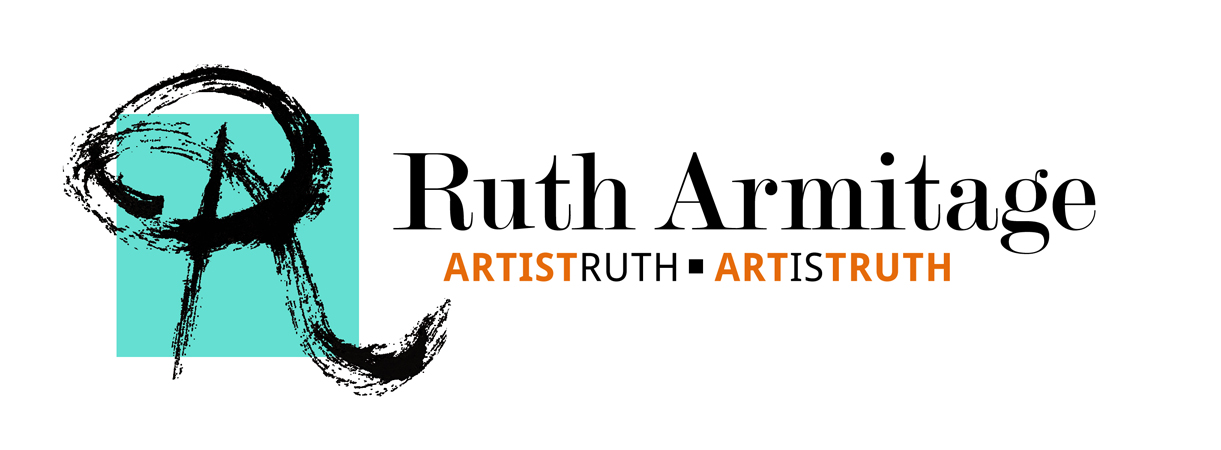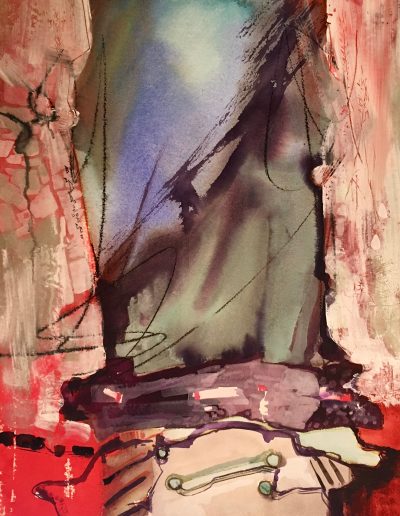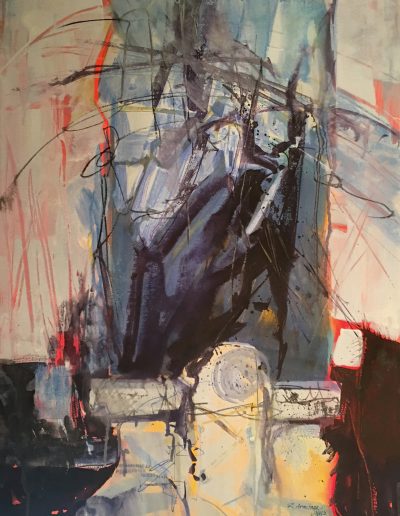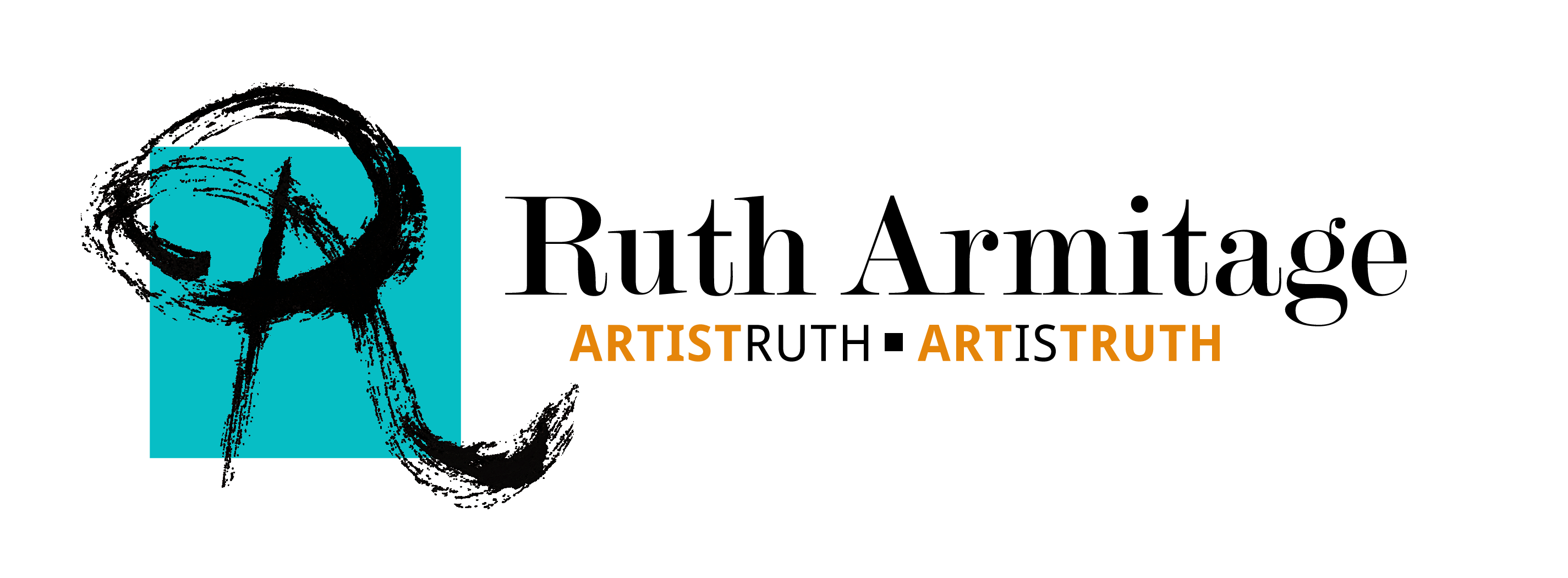Most serious Artists and Collectors agree that focus is important for an artist’s body of work. Focus provides continuity from one painting to the next, and allows the work to hang together when presented en masse. But how does one go about creating a focus in their work? And for collectors, how does one amass a collection that works together? Here are a few ways to cultivate or create focus.
1. Focus on Subject Matter
Probably the most common way that collectors create focus is to concentrate on collecting a particular type of work. Some are drawn to landscape, while others prefer abstract or figurative paintings. Similarly, artists often gravitate toward particular subject matter.
My own work has always focused on narrative, despite the genre. The earliest still life paintings incorporated objects precious to me that told a story. The “Haunting Aunties” figurative paintings also tried to convey a sense of storytelling about family history and bonds. My current abstract work is also based upon narratives surrounding my rural upbringing and connection to the farm where I was raised. Because I know what my main interest is, I can delve into sub-plots and explore different stories in an in-depth way.
2. Focus on Design Elements
One thing I try to convey in my workshops is that each artist may be drawn to different means of expression. Some artists prefer to emphasize color, while others may be more interested in using line. Collectors may also have some of the same predilections. One patron may prefer to collect work that is bright and colorful, while another may prefer black & white photographs or drawings, yet another person may be drawn over and over to primitive pattern work or sculpture.
I have a strong bias toward using color. Warm and cool contrasts have always captivated me, and my eye is always drawn to new color combinations. I’m currently focusing on using subtle color contrasts wherever I can.
3. Focus on Style
Even if an artist decides that they will focus on the landscape, for instance, various works may not be cohesive in a body of work because of different styles. For instance, a single realistic black and white landscape would stand out from a group of colorful abstracted landscapes. If an artist is true to their own vision and pursues a style that fits their temperament, the work is more likely to be cohesive. By committing to working in a specific style, the artist’s work will gain focus. Collectors often prefer to purchase work in a certain style as well.
Currently, my focus in on an abstracted, almost non-objective style. Within the spectrum of abstraction, I tend to fall toward the very abstract, even though much of my work originates in a very real subject.
4. Focus on Medium
Many collectors prefer to collect the majority of their work in one medium, such as watercolor or oil or sculpture. Artists, too, can often be known for their work in one medium.
Personally, I have enjoyed exploring watercolor, gouache, collage, drawing, acrylic, encaustic, cold wax and oil. Although my work spans many mediums, my application of the various types of paint or pigments often makes it difficult for viewers to tell what the medium is. This is because my brush-work, palette and shapes are fairly consistent between mediums.
5. Focus on a Series
Many artists make work in a series, each individual piece relating to the broad idea and yet differing from its companion pieces in varying degrees. The individual pieces may focus on different facets of the idea or different conditions. The artist Claude Monet is an artist who worked on different series during his career. His most famous may be the Water Lilies – a series of work inspired by the lily pond in his garden. He also painted a series of work exploring different light conditions on haystacks and on Rouen Cathedral.
For me, painting work in a series give me an opportunity to experiment with color and to explore different facets of the broader idea of my farm upbringing. My earlier series the “Haunting Aunties” explored the influence women, especially women in the family, have on each others’ lives.
An example of focus in a series
Here is a peek at how working in a series helps me to refine my ideas. Below are three paintings, all of the same subject. These paintings all began in my workshop in Springfield – The ABC’s of Abstraction. They became increasingly abstract as I worked on them. I began with the idea of painting my dad’s shoe and pant leg from memory. He used to keep cigarette butts in the cuff of his jeans to avoid fire danger in the summer. This idea is a potent memory of my dad.
I began with the image on the left. It focused on the leg of Dad’s Levis, and you can see the white cigarette butts in the cuff shape near the bottom. The second image shown is actually the third painting of this subject. In this painting I decided to focus more on the shoe, even though the cuff and cigarettes are still there. I also emphasized line more in this image. The third painting is titled Effigy. An effigy is a symbol of a person, often used as a monument and sometimes the ‘butt’ of angry demonstration. I thought the title fit the almost iconic representation of this symbol for my dad. I feel this image still has echoes of the previous images, but I like the abstraction – how the paint is beautiful on its own without the subject matter.
How have you found focus in your work or your art collecting? Click below to leave me a comment or share with a friend.
“Abstract literally means to draw from or separate. In this sense every artist is abstract… a realistic or non-objective approach makes no difference. The result is what counts.”






Informative and thought provoking, especially your pants/shoe examples. Thanks so much for these ideas. Will share!
Thanks for taking time to leave a comment, Sue! I appreciate your share too!
I found your description of your process fascinating. I really appreciate your sharing that and the three paintings!!!
Thanks Jansi! I appreciate you taking time to leave me a comment!
Narrowing my focus has always been a problem because I want to try my hand at any art technique that piques my interest, but it’s solved itself naturally as I’ve evolved as an artist. It helps to see how you break down “focus” into five elements. Here’s what I came up with after reading your very thoughtful post. 1. Like yours, my work is narrative. It tells an autobiographical story though that isn’t always apparent to the viewer and is a way I can engage the viewer in direct conversation. 2. Design is where it’s “at” for me. Design and composition are the foundations upon which I build my work. If good solid design isn’t there I consider the piece a failure. 3. My style has naturally evolved and is quite abstract but usually is representational. People comment that they always recognize my work. 4. I work mostly in collage using acrylic to paint my papers. I also love doing urban sketching using ink and watercolor. 5. There are several series in my work. I began using my collection of road maps years ago, making collages about places I’ve been. Then there’s the Little Jo series on small collages using photos of me as a child. And the most recent series is street scenes, collages based on my photographs.
Sorry for the long answer but it’s helped my focus to treat this as an assignment, one teacher to another. Thanks, Ruth.
I appreciate seeing how you respond to the way I’ve broken down the ways to focus, Jo! I’m glad you found the post a valuable tool to analyze your focus 🙂 I think most artists are attracted to new art techniques and mediums. The challenge is to make sure that the new idea fits into the focus of our work!
Ruth: Richard Diebenkorn was my idol when I was an art student in the San Francisco Bay Area in the late 1970’s, quoting him at the end of your post resonates with me on so many levels. Before I read through your post, I looked at your three paintings that you presented as examples. They seemed so strong and appealing for the color, values, forms, line work, composition. Gorgeous! I saw nothing representational in them. Then I read your post telling about your father’s pant leg, and I saw that image immediately. I very much appreciate that the paintings could stand alone even without the narrative or subject matter.
Thank you so much Toni! One of the drawbacks of working abstractly is that I still see the subject matter each time I look at the painting! It is good to know that you didn’t need to know the subject to appreciate the paintings.
Great article for a beginner like me! “Dare I step off the cliff into the world of abstraction?” I ask myself. I have no answer yet, but your article gives me insight into what might be possible. Thanks Ruth!
Thanks Peg! Glad you found it interesting. Maybe you could do some experimenting 🙂
Thanks for your post. My painting instructor shared it with me. You “unwrapped” your process beautifully, and I will reread and ponder it as I continue my journey in abstraction.
Alicia- I appreciate your comment! And let your instructor know that I appreciate them sharing too!